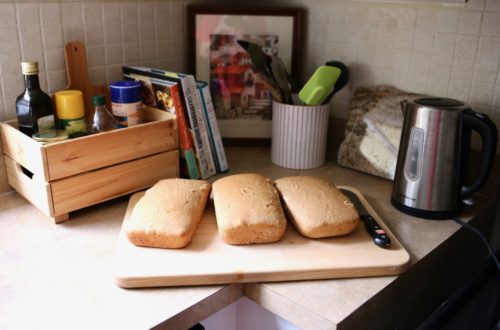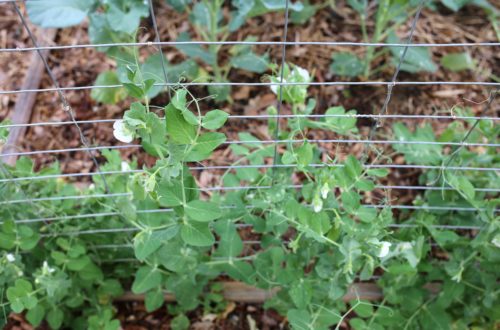the daily salad.
 I used to eat salads because I felt like I should. Now I eat salads because I love them.
I used to eat salads because I felt like I should. Now I eat salads because I love them.
I thought I’d tell you why.
I’m pretty sure I first started craving salads in South Asia — when actually creating something like the photo above was an all-morning affair. We were supposed to avoid raw vegetables that hadn’t been treated with some sort of disinfecting rinse. So every vegetable purchased at the market had to be soaked for 15 minutes and rinsed for 15 minutes and dried.
Sound simple? Try doing this with every component of your salad: lettuce, carrots, tomatoes, cucumbers. Then do it with all your fruit. But you can’t use your tap water – so be sure to fill up big plastic bins with the impossibly slow drip of your water filter. Every time you come home from shopping (which, in and of itself, is an exhausting process).
Very soon you lose the will to make that salad.
When we moved back home my nutritionist urged me to get as many raw fruits and vegetables into my diet as possible since we were focusing on rebuilding my immune system, and she suggested a daily salad for lunch as a great habit.
Over the last year and a half of practicing this habit, I’ve begun to sing its praises for two reasons: 1. My daily salad tastes great, and 2. I feel great afterward.
Here’s what I suggest: start with your greens. Please, please do not ever buy Iceberg lettuce again. It is a sure guarantee to make you hate your salad (unless you slather it with tons of Ranch dressing, in which case you are eating Ranch dressing and not a salad). I like Romaine, but prefer Red Leaf or Bibb lettuce. Or a combination. I also add spinach as often as possible (or just use spinach as the whole base as shown above).
Side note: I’ve learned to chop and wash my greens in a salad spinner when I get home, dry on cloth or paper towels on the counter, then roll up in the damp towel and store in the fridge in a ziplock bag. My lettuce has kept for up to two weeks this way.
Next, chop your veggies: Carrots and radishes, cucumbers, tomatoes in the summer. Raw broccoli. Grated beets. Grated sweet potatoes or cabbage.
And now, here’s where it gets fun. Leftover roasted veggies from last night’s dinner in the fridge? Go ahead and throw them on there (roasted sweet potatoes. yum.). Leftover brown rice or quinoa? Yup.
I always like a handful of something crunchy: chopped nuts or sunflower seeds.
Definitely, definitely olives if you have them (but please not canned, please buy the nice jarred olives or the package in the Publix cold imports section). It’s okay if you don’t like olives though.
Want to know something weird about me? I hated olives my entire life. As in, they made me shudder. David’s family always served them for appetizers with cheese and crackers and I never touched the things. Then, in South Asia I was diagnosed with low blood pressure and told to consume more salt. And at about exactly this time I began to adore and crave olives. And ever since I can’t get enough of them. Now at Gentino family gatherings I’m always looking for the olives.
Anyway, back to our salad.
Cheese is optional. I try to limit dairy, but I seem to be fine with it in moderation — especially with hard cheese like Parmesan, or goat cheese. Get a really good-quality Parmigiano Reggiano cheese and add a couple shavings to your salad (or soup. or scrambled eggs. or anything really). I learned this from Mark Bittman and it’s been a revelation. It’s more expensive of course. But because it’s so much more flavorful you only need a tiny bit.
At this point I usually chop a hard-boiled egg to sprinkle on top because for me the extra protein helps the salad to last longer in the afternoon (although I always need a snack before dinner).
Another revelation: learning from my friend Erika how to properly cook an egg (submerge in a pan of water, heat to boil, turn heat off and set timer for 9 minutes, immediately drain and rinse in very cold water to stop the egg from cooking). Your egg will taste soft and flavorful — rather than like something you could drop on the floor and watch bounce.
Once everything is assembled it’s time to season and dress your salad. How did I make it almost 32 years of life without learning to put salt and pepper on my salad? I don’t know, but fresh-ground sea salt and black pepper make all the difference.
Finally, I’m going to suggest something that may be hard for you to hear: I want you to try to stop using store-bought salad dressing. I know. That’s shocking. Maybe going too far. Once my friend Josh said his wife Sarah refused to ever eat bottled salad dressing and I thought she was crazy (sorry, Sarah!).
Alas. Now I’m converted.
In my opinion (and I’m sure Sarah’s too), you never get to enjoy the actual taste of your salad with those dressings. I should know: the only way you could get me to eat a salad before was to cover it with Ranch. I loved the stuff. But now I realize what I said before: it kind of just makes everything on your plate taste like Ranch.
I had to give up almost all bottled salad dressings when I went gluten-free (which should be your first hint: Why do you need wheat in something like a salad dressing? Because it’s a preservative, that’s why. It’s what makes your dressing last for months weeks in the fridge).
It was hard at first. But my nutritionist gave me some great suggestions: extra virgin olive oil is wonderful (again, for salads you really need to buy nice olive oil in the dark green bottle). With a drizzle of good-quality Balsamic vinegar. Or, my personal favorite: a generous squeeze of lemon juice.
I’ve looked up lots of recipes and made homemade salad dressings several times. They were always simple and delicious. And don’t get me wrong: a made-in-house Caesar salad dressing is one of my all-time favorite things. But I think creamy, heavy dressings like that are better saved for special occasions. You just don’t need them to make your daily salad good.
The velvety smoothness of extra virgin olive oil and the bright tang of lemon juice are the perfect accompaniment to a salad. David and I like this combination so much we rarely use anything else.
And there you have it. Your daily salad. I never get tired of it, because you can always switch things up here and there, based on what’s in season or what you have in your fridge.
And like I said, the very best part about my salad is the way I feel afterward — light, energized. Rather than sluggish and sleepy like if I eat a big, heavy lunch.
I know, I know, you may be thinking: That’s all well and good for you, Julie. But you stay home. You get to make your lunch every day. But I have to go to work.
I hear you. However, my mom has been taking salads to work for years and certainly way before I ever considered salad as something I’d want to eat. I pack my and the kids’ lunches for Classical Conversations each Monday and find a salad is a great portable lunch (it just takes a tad more foresight. but it’s worth it, i promise!).
Okay, enough from me. Now it’s your turn: what, in your opinion, makes a good salad?



2 Comments
Linda Gentino
Jules, this is a wonderful post!!! I’m about to get off the computer and make my weekly shopping list and will be sure to stock up on salad supplies. One thing it does is eliminate the question of what to pack for lunch.
Kaitlin P Suits
Uhh I was going to say Ranch (Hidden Valley!) 😉 But I’ll go with big, fresh tomato wedges that you cram into your mouth and cucumbers! Your salad is a work of art…looks delicious!